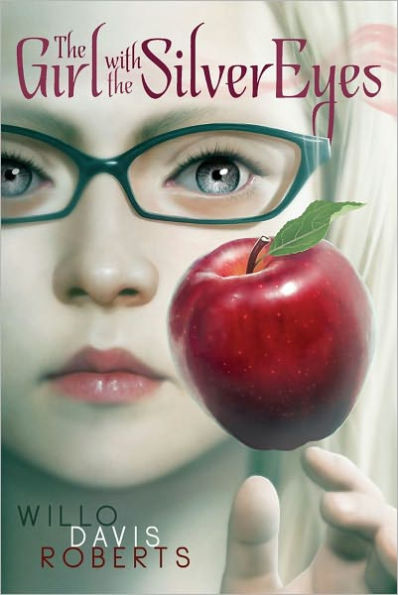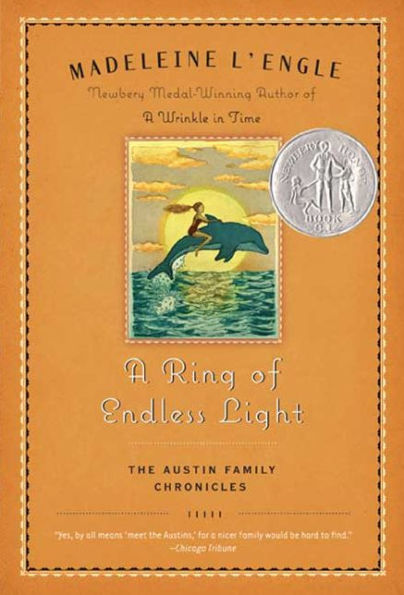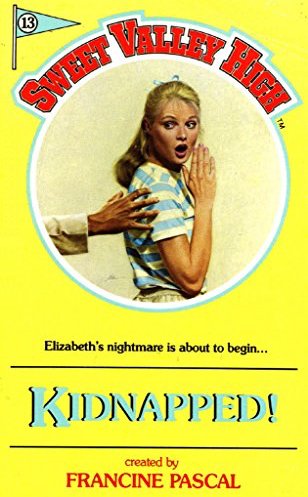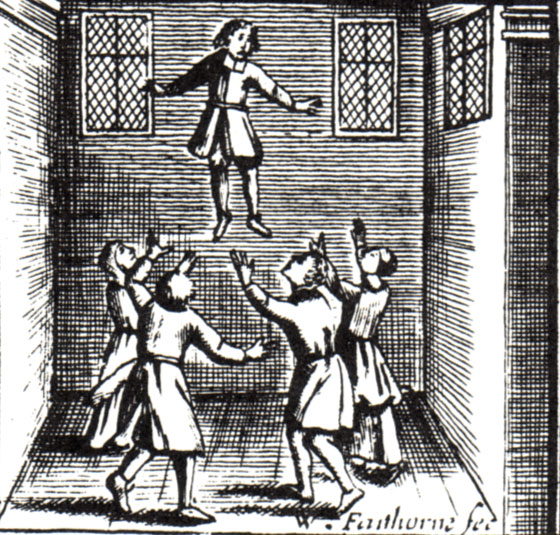In the world of SFF, books are positively littered with supernatural protagonists, many of them young people just coming into their power as they hit their teen years. But one thing that has always been interesting to me are stories that are utterly realistic—even gritty—until suddenly, out of nowhere, one of the protagonists turns out to be telepathic or telekinetic or psychic. I’ve been thinking about a few specific titles that meet these standards, mostly heavy slices of socially realistic YA that abruptly drop their readers into the icy waters of fantasy. Here are five such books—can you think of more titles that fit the bill?
The Girl with the Silver Eyes by Willo Davis Roberts
I read this at some point in the blur of elementary school, and the reason I include it is that it seems like an innocuous coming-of-age tale, shelved with other stories of prepubescent misfits, and its world is entirely realistic. Katie Welker lives in an apartment with her mom and step-boyfriend, her somewhat abusive grandmother just died, she’s still trying to adjust to her family’s new paradigm, and she doesn’t have any friends. But… she has silver eyes!!! Not just grey, or even gray, but silver. And, as becomes clear to the reader—a bit sooner than it does to the character—she’s telekinetic! And she can talk to animals, kinda! She’s comfortable with her ability, and uses it to turn pages while she’s reading and turn lights off without getting up, but it makes everyone else nervous. Noticing this, she sometimes uses it to frighten babysitters. But her gift also makes her lonely, until she learns that she was probably born telekinetic because her mom worked at a pharmaceutical factory, and there might be others like her. And then because this book was written in the ’80s, when children left home in the morning and didn’t return until they were hungry, she’s able to go out alone and find the others—and it turns out they do have powers. At which point the book takes a hard turn back into social realism as the kids team up not to fight supervillains, but to investigate the mundanely evil pharmaceutical company.
Which, I mean that’s a choice, I guess?
Buy the Book


The Girl with the Silver Eyes
A Ring of Endless Light by Madeleine L’Engle
Many of Madeleine L’Engle’s most famous works are fantastical, and feature teens with supernatural powers, talking unicorns, literal cherubim, and the idea that everyone in existence is locked in a constant cosmic battle between vaguely Christian Good and vaguely materialistic Evil. But not so in her Austin books! L’Engle’s other big series followed Vicky Austin, who is a dreamy teen girl who wants to be a writer, growing up in a loving family during a nebulous time that seems to be more-or-less the mid-1960s. After her beloved grandfather dies, Vicky ends up spending a lot of time with Adam Eddington, a marine biologist-in-training who also works with Calvin O’Keefe occasionally in L’Engle’s other books. But more important, she spends time with Adam’s dolphins, Basil, Norberta, and Njord (fucking L’Engle), and discovers she can commune with them in a way that is basically the glittery psychic dolphin connection that was promised to all of us by Lisa Frank and her bewitching artwork. Vicky’s talent culminates in a scene toward the end of the book when she unwittingly “calls” Adam during a moment of crisis, but these psychic flashes are brief moments in what is otherwise a realistic exploration of grief and romantic awakening.
Buy the Book


A Ring of Endless Light
Sweet Valley High #13 Kidnapped! by Francine Pascal
OK, granted, calling Sweet Valley High, in any of its incarnations “realistic” is a little bit of a stretch. But generally speaking everyone at least obeyed the laws of physics while they were all disproportionately rich/gorgeous/turquoise-eyed. This goes out the window in the thirteenth installment of the Original Series, titled Kidnapped! In this entry, Elizabeth Wakefield is, you guessed it, kidnapped, by an orderly at the hospital where she’s volunteering as a candy-striper. Again, by Sweet Valley standards, this is a normal week. Where it gets weirder is that not one but two separate people have premonitions that something is wrong after Elizabeth is kidnapped, but before anyone knows she’s missing. One person is her jerk twin, Jessica, and that makes sense—it’s completely within the bounds of teen fiction that twins have psychic connection. What’s more notable is that Jessica has two separate moments where she “knows” something is wrong, and that she shakes both of these moments off so she can flirt with a guy she likes. But a “punk” kid Elizabeth is tutoring also has a premonition. He just knows something is wrong, and finally investigates her disappearance himself before teaming up with Jessica and Elizabeth’s useless boyfriend, Todd. So, spoiler alert, they find Elizabeth, she’s fine, and lives to be manipulated by Jessica in approximately 137 future books, but for one weird moment there are two different psychic teens on the loose in Sweet Valley, California.
Buy the Book


Kidnapped! (Sweet Valley High Book 13)
Emily of New Moon and Emily’s Quest by L.M. Montgomery
This is another not-quite-as-famous series by a beloved author. L.M. Montgomery is primarily know as the author of the resolutely realistic Anne of Green Gables series, which follows a young redheaded orphan (who kinda wants to be a writer) through romantic trials and triumphs in Edwardian Canada. Emily of New Moon, my preferred Montgomery work, follow a black-haired orphan (who really, really wants to be a writer) through romantic trials and triumphs in Edwardian Canada. The difference between the two series is that Emily actually dedicates herself to her writing and sees some success despite the misogyny of the time, and also she’s fucking psychic. Two separate times over the course of the series she has several three-dimensional, full color, totally immersive visions. One concerns her best friend, Ilse Burnley. Ilse is practically feral, having been abandoned by her father, Dr. Burnley, who believes that Ilse’s mother left him for another man. It’s all very tragic and convoluted (especially as filtered through the points of view of two prepubescent Edwardian children—thanks, Lucy Maude) but it leads to a lot of misery. UNTIL. Emily contracts measles, nearly dies, and has a vision of a young woman running through a field and falling into a well. She recites the vision in a terrifying voice, the well is investigated, and voila! There are the bones of Ilse’s mother, who didn’t run away at all (yayyy!) but fell into a well and died (um, yay?). This has the happy (???) outcome of Dr. Burnley actually caring for his daughter. The second incident is much creepier. When Emily’s on-again-off-again artist boyfriend, Teddy, is about to leave for Europe, she falls into a fit. Hundreds of miles away Teddy sees her across a crowded dock, and follows her until he loses sight of her. This causes him to miss boarding his ship—which then sinks, killing everyone aboard. This isn’t even just telepathy or a psychic vision of some type, this is full-on bi-location! Teddy lives, tells Emily about it weeks later when he sees her again, and everyone in the book just goes about life as though they don’t have a superhero in their midst.
Buy the Book


Emily of New Moon
Tree by Leaf by Cynthia Voigt
Another lesser-known title! Cynthia Voigt’s best known books are Homecoming and Dicey’s Song, both ultra-realistic YA fiction of the ‘80s variety, in which a group of abandoned kids have to take care of themselves in a tough and unforgiving world. And those are great. But the book I’m interested in here is Tree by Leaf, which is about a young girl named Clothilde (which I still to this day do not know how to pronounce) who lives in an otherwise realistic New England. Her father has come back from World War I a shattered, silent man, her mother has abandoned the tasks of running the household (leaving Clothilde to do it all), and her brother has left the family to live with other relatives. Again we have a novel of grief and coming-of-age. But then Clothilde has an awe-filled experience in the woods when a strange and otherworldly voice speaks to her. She becomes hyperaware of life around her, hearing sap running through veins on leaves, seeing individual blades of grass growing—for a time. As terrifying as this is, she is grief-stricken as the effect fades away and she returns to normal perception. After this, however, she realizes that she can maybe, somewhat, read people’s thoughts and emotions in a way that she couldn’t before. Everything else about the book is completely realistic, but Voigt leaves the experience in the forest whole and uncanny. Was it a dream? Was it some form of deity? A hallucination?
Buy the Book


Tree by Leaf
Now it’s your turn—do you have any favorite books that lulled you into a sense of realistic safety, only to take a sharp turn into the supernatural?
Leah Schnelbach was never a supernatural teen, but will settle for being a supernatural adult. Come levitate with them on Twitter!











Clo-tild,or if you prefer: Clo-til-deh. Accent on second syllable.
Jane Eyre, of course, and Jane’s telepathic communion with Mr Rochester (“Jane ! Jane ! Jane!”) at a moment of crisis. Although in typical Jane fashion, she refuses to believe that there’s anything supernatural about it:
“Down superstition!” I commented, as that spectre rose up black by the black yew at the gate. “This is not thy deception, nor thy witchcraft: it is the work of nature. She was roused, and did—no miracle—but her best.”
In Kathy Reichs’ Virals series, teens are exposed to a virus that gives them stock superpowers: super strength, speed and enhanced senses. An interesting detail is that one of the teens is the niece of the lead character from the utterly conventional mystery series about Temperance “Bones” Brennan. It’s kind of like discovering Miss Marple is related to Miracleman.
Justine Larbsletstier’s Liar.
Are you drawing some sort of personal distinction between “gray” and “grey” that’s opaque to the rest of us, or is that a typing error?
The Secret Hour and it’s series companion books of The Midnighters Trilogy by Scott Westerfield.
About a small group of teens who acquire supernatural talents in the “hidden hour” between the ticks of the clock between midnight and 12:01am. There are some pretty nasty Supernatural beasties who roam the hidden time, sealed away from the “real” world, and the series is about how the kids go about defeating them, more-or-less permanently so they can’t break into normal time.
@5: It’s a (slight! loving!) dig at L’Engle, who had characters in a few of her books argue about how the different spellings of “grey” changed the word’s tone. I actually agree with her – but it also amuses me. :)
About Emily: her psychic flashes happen once per book. (The second Emily book, she has a premonition about where a lost little boy is and does some drawing in a trance.)
I LOVED The Girl With The Silver Eyes. It’s the first time I’ve ever seen anyone else bring that up!
AND THIS IS LAURA by Ellen Conford. She thinks she’s the boring one in her family, but then it turns out that she has some kind of clairvoyance.
WATCH ME DISAPPEAR by Janelle Brown. Olive’s mother is presumed dead in a hiking accident, but then Olive begins having intense visions pointing to something she couldn’t possibly have known…
“Matilda” by Roald Dahl certainly isn’t having a normal child, but the telekinesis is still quite unexpected!
A GIFT OF MAGIC by Lois Duncan. A coming of age story of three kids, one of whom is clairvoyant and can read minds.
In Nina Kiriki Hoffman’s The Silent Strength of Stones, teenager Nick Verrou gradually discovers his capacities as a member of the magically empowered Chapel Hollow families. Not without a fair swatch of troubles on the way.
I’m absolutely stunned to see that someone else remembered the Ellen Conford book. And the Willo Davis Roberts! Tor readers, don’t ever change.
Vicky Austin’s grandfather is not dead in A Ring of Endless Light!! He has cancer and is definitely dying, but not dead. It’s an important distinction and one that adds to the complexity of the book, and the ambiguity of Vicky’s feelings.
Girl with the Silver Eyes fans REPRESENT. As a weird loner kid, the idea that there were other weird loner kids who I could connect with on a deep mental and emotional level was probably the ultimate fantasy, hence why I’m still so fond of it 20 years later. I’ve long wished we could have seen a YA sequel about the kids all growing up together, but alas.
I also literally never open a can of tuna fish without remembering this book. Willo Davis Roberts really inoculated me into the world of can opener safety.
I loved Girl with the Silver Eyes!! I think I ordered it from a Scholastic Book Fair. My other favorite was (still is!) The Silver Crown, by Robert C. O’Brien, author of Mrs Frisby and the Rats of NIHM.
One book that doesn’t exactly meet your pattern, but is kind of similar is Jane Louise Curry’s _Beneath the Hill_, which starts like a story by Elizabeth Enright or maybe Eleanor Estes, about a family of kids and maybe a neighbor or two or a cousin, just living life in the ?late 60s? in the U.S. The protagonist doesn’t develop powers suddenly, but she finds an old key or something, and is using it as a sort of object or prize in a sort of game, treasure hunt that she’s providing clues for her siblings or friends to to unravel and find. It’s like Enright’s _Spiderweb for Two: A Melendy Maze_, or seems to be. Of course, those sorts of books can be the beginning of a Fantasy story in the mode of E. Nesbit (but she also wrote those Bastable Children books which were not fantasies). However, I never saw another book without more hints along the way that takes one hundred pages before the fantasy element comes in. And we’re talking a full underground Elvish civilization that came to the American continent when sailing for Hy Brazil, and got preoccupied with the loveliness of the New World and didn’t bother to move on until it was extremely difficult…. Kind of like Columbus, they ran into an unexpected continent in The Atlantic instead of sailing into the mists of the other Faerie dimension. It’s been a while since I read the book, which is the first in a series of books that Curry wrote, many set in the Welsh past of the 800s or 400s or something, the Abaloc series or something. I like the book, by the way, best among the books I read by her. But as much as I *did* like the Elves in America and all, I kind of missed the turn from the _Spiderweb for Two_ type book I thought I was reading.
It’s not often I see anyone mention The Girl with the Silver Eyes! Nice. :)
Into the Dream by William Sleator was a favorite of mine. Two teens find they’re sharing the same nightmares and race against time to save a youngster from disaster.
The Blossom Culp series by Richard Peck features a young lady who can talk to ghosts. It’s set shortly after the turn of the 20th century and I remember them being quite good.
The Haunting of Cassie Palmer by Vivien Alcock. I love ghost stories …
A newer book on the scene by Nnedi Okorafor is Akata Witch. It’s set in Nigeria and is based off local Nigerian folktales and traditions. Very different and very good.
Well, there’s “Slan” although it didn’t exactly take an unexpected turn. <g> I read it when I was 9 or 10 and it made a big impression on me although even then I could see that Van Vogt was a bit clumsy at the writing bits. <g> The Harry Potter series definitely qualifies. The adolescent with Powers is a wish fulfillment theme that will never die.
The Girl with the Silver Eyes was one of my favorite books as a young girl in the 80s, and until just now I had believed that no one else had ever heard of it!
@18 – I had forgotten all about how much I liked Into the Dream, and now I’m going to have to seek out a copy to reread. I remember it being ultimately kind of sweet, which officially makes it the only William Sleator book not to terrify and/or deeply disturb me. (Just thinking about the Green Futures of Tycho still kind of messes me up).
The Blossom Culp books were great. A Gift of Magic by Lois Duncan was great. The Girl with the Silver Eyes was so good that I read it multiple times as a 9-10 year old. I never encounter anyone IRL has read these, and since they’re children/YA books, nobody I mention them to ever reads them. Rather an amazing thing to see all three of these books mentioned in the comments here!
What about John Wyndham’s “The Chrysalids”? Divergence, difference and superpowers. And, of course, persecution.
Did you really intend to apply a rude adjective to L’Engle, or did this page get hacked?
@21, oh my yes, how could I forget the Blossom Culp books!
What the heck?! How has no one said anything about the “Jumper” series by Steven Gould? Gritty, check. Extraordinary abilities, check! Great book, check? Terrible movie and web series, unfortunately check-o-rama. :(
C Baker, I always felt that gray was reddish gray and grey was yellowish. Don’t ask me why, perhaps grey’s e translated to yellow’s e, but that makes the gray one an anomaly. But I can see the two colors and they are quite different.
So back in the 1990s there was this series of novels, I think edited by Datlow and Windling and with Tom Canty covers, of modern fairy tale retellings. I read three:
1: Briar Rose, by Jane Yolen. A totally mundane book using Sleeping Beauty as an interpretive lens for a Holocaust survivor.
2: The Sun, The Moon, and the Stars, by Steven Brust. A totally mundane book about a bunch of artists, with a Hungarian fairy tale interleaved.
3: Tam Lin, by Pamela Dean. A totally mundane book about college. With some weird Classics majors and a campus ghost story. But hey, it’s going to turn out to be mundane, right? That’s what this series is all about, clearly! …until near the end of the book, when the not at all mundane fantasy elements become undeniable.
I figure normal readers were probably surprised, but I’d been set up to be really really surprised.
***
On a different front, the webmanga? (not sure what it is) Mousou Telepathy features a mind-reading girl from the very beginning, but it’s otherwise a mundane and realistic story. I mean, the telepathy is central, but there’s no psychic battles or crime-stopping or running away from government agents, just one high school girl with a mysterious and awkward power, trying to get through school and social life.
(It’s involuntary mind-reading, like hearing people’s thoughts. So the sucky kind. Especially when there’s a boy nearby with all sorts of lewd thoughts about you.)
CHip – consider this
Njord is the God of the wind and fertility as well as the sea and merchants at sea and therefore was invoked before setting out to sea on hunting and fishing expeditions.
I rather suspect the comment was simply one of abject admiration at L’Engle’s uncommonly deep research and vivid choices, not intended rudely ;-)
What about FIRESTARTER, THE SHINING, and, er, about half of Stephen King’s books? Poppets with amazing powers show up all over the place in his works (and usually need to).
Carrie is telekinetic and scared out of her wits. Also falls under the classic bullied high school teen trope.